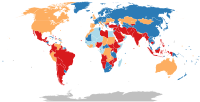
Photo from wikipedia
Introduction CoronaVirus Disease-2019 (COVID-19) led to social distancing and the need for alternative care models. Telehealth programs for people with Parkinson's (PWP) disease may ensure continuity of care. The goal… Click to show full abstract
Introduction CoronaVirus Disease-2019 (COVID-19) led to social distancing and the need for alternative care models. Telehealth programs for people with Parkinson's (PWP) disease may ensure continuity of care. The goal of this observational survey study was to determine the practicability, satisfaction, and barriers to online programs, their relationship to perceived symptoms, mood, and quality of life, and program sustainability beyond the immediate pandemic. Methods In-person Parkinson's programs at New York Institute of Technology College of Osteopathic Medicine transitioned online at the start of the pandemic to include Rock Steady Boxing, Support Groups, and Rock Steady Buddies. A custom online survey sent to 150 participants investigated PD history, symptomatology, level of exercise before and during the pandemic, depression (PHQ-9), quality of life (PDQ-39), and practicability and perceived satisfaction related to these online programs. Descriptive statistics were reported. Results Of 69 respondents [mean age of 70.2y (SD 8.4 yrs)], >75% were satisfied with the transition to online programs. Consistent attendance and minimal barriers to programs indicated practicability, with increased adherence to exercise. Of 66 completed PHQ-9s, 22.7% had scores ≥9 (moderate to severe depression); of 61 completed PDQ-39s, scores averaged 21.4; better quality of life than national averages for PWP. Self-perceived physical and mental wellbeing were positively affected. Conclusions Results suggest the transition to online programs met the needs of the Parkinson's community in a practicable and sustainable manner during the pandemic. With COVID-19 still prevalent, the current model of blending synchronous online and in-person classes provides a more flexible, sustainable format compared to in-person alone. Institutions may consider including online components to existing programs to promote continuity of care for aging populations as part of best practices.
Journal Title: Frontiers in Public Health
Year Published: 2022
Link to full text (if available)
Share on Social Media: Sign Up to like & get
recommendations!